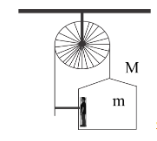
A man of mass m stands on a crate of mass M. He pulls on a light rope over a smooth light pulley. The other end of the rope is attached to the crate. For the system to be in equilibrium, the force exerted by the man on the rope will be
A. $ \left( {M + m} \right)g $
B. $ \dfrac{1}{2}\left( {M + m} \right)g $
C. $ Mg $
D. $ mg $


Answer
553.8k+ views
Hint: Consider the tension on the rope due to both the pulling and due to its attachment to a crate. Then use Newton's third law of motion to establish the equilibrium condition for the system. Once the tension on the rope is calculated, then we can easily show how much force is exerted by the man.
Complete step by step solution
Let $ T $ be the tension on the rope. Now we are told that the pulley is being pulled from one side by a man and the other end of the rope is attached to a crate. So there is tension on both the side of the rope such that the total tension becomes $ 2T $ .
If $ m $ be the mass of the man and $ M $ be the mass of the crate then the total mass will be $ $ as the man is standing on the crate.
$ g $ being the acceleration due to gravity, the total force acting downwards is $ \left( {m + M} \right)g $
For the system to be in equilibrium, the total tension on the rope acting upwards must be equal to the force acting downwards.
Thus, we can show that $ 2T = \left( {m + M} \right)g $
$ \Rightarrow T = \dfrac{1}{2}\left( {m + M} \right)g $
We know according to Newton’s third law of motion that every action has an equal and opposite reaction so when the man pulls the rope downwards, an equal and opposite force called the tension acts on the rope in the upwards direction. Thus from this we can say that the force exerted by the man on the rope is equal to $ T $ .
So, the correct option is B.
Note
Tension is a form of restoring force which can only pull. This is due to the fact that tension only comes into play when we consider systems involving strings, ropes or cables. Other types of restoring force are involved in simple harmonic motion.
Complete step by step solution
Let $ T $ be the tension on the rope. Now we are told that the pulley is being pulled from one side by a man and the other end of the rope is attached to a crate. So there is tension on both the side of the rope such that the total tension becomes $ 2T $ .
If $ m $ be the mass of the man and $ M $ be the mass of the crate then the total mass will be $ $ as the man is standing on the crate.
$ g $ being the acceleration due to gravity, the total force acting downwards is $ \left( {m + M} \right)g $
For the system to be in equilibrium, the total tension on the rope acting upwards must be equal to the force acting downwards.
Thus, we can show that $ 2T = \left( {m + M} \right)g $
$ \Rightarrow T = \dfrac{1}{2}\left( {m + M} \right)g $
We know according to Newton’s third law of motion that every action has an equal and opposite reaction so when the man pulls the rope downwards, an equal and opposite force called the tension acts on the rope in the upwards direction. Thus from this we can say that the force exerted by the man on the rope is equal to $ T $ .
So, the correct option is B.
Note
Tension is a form of restoring force which can only pull. This is due to the fact that tension only comes into play when we consider systems involving strings, ropes or cables. Other types of restoring force are involved in simple harmonic motion.
Recently Updated Pages
Why are manures considered better than fertilizers class 11 biology CBSE

Find the coordinates of the midpoint of the line segment class 11 maths CBSE

Distinguish between static friction limiting friction class 11 physics CBSE

The Chairman of the constituent Assembly was A Jawaharlal class 11 social science CBSE

The first National Commission on Labour NCL submitted class 11 social science CBSE

Number of all subshell of n + l 7 is A 4 B 5 C 6 D class 11 chemistry CBSE

Trending doubts
Differentiate between an exothermic and an endothermic class 11 chemistry CBSE

10 examples of friction in our daily life

One Metric ton is equal to kg A 10000 B 1000 C 100 class 11 physics CBSE

Difference Between Prokaryotic Cells and Eukaryotic Cells

1 Quintal is equal to a 110 kg b 10 kg c 100kg d 1000 class 11 physics CBSE

State the laws of reflection of light




